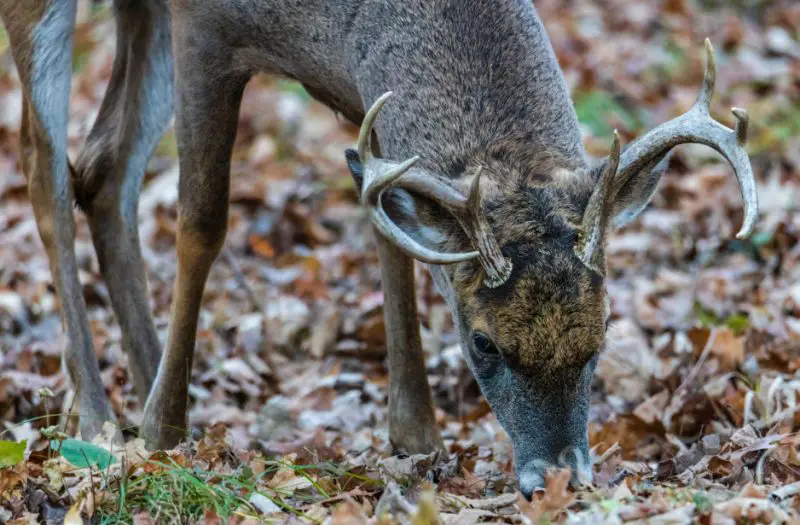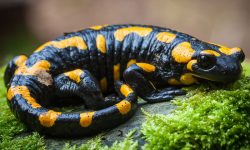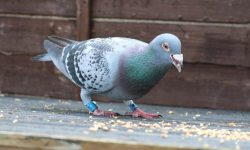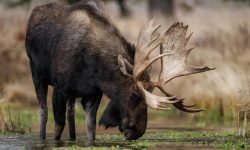Stags, the mature males of deer species, are powerful herbivores that thrive in forests, mountains, valleys and meadow ecosystems. Their impressive antlers, muscular builds and seasonal behaviors often draw attention, but their diet plays a far more critical role in shaping their daily lives. Understanding what stags eat reveals how they maintain strength for rutting season, survive harsh winters and adapt to changing environments across continents.
Stags follow a plant-based diet that shifts with the seasons. During spring and summer, they focus on nutrient-rich vegetation that supports antler growth and muscle development. When autumn arrives, they seek high-energy foods to prepare for mating challenges. Winter forces them to rely on hardy, fiber-rich plants that persist beneath snow. Their selective feeding patterns help maintain ecosystem balance by shaping plant communities and nutrient cycles.
This detailed guide explores 20 foods stags consume in the wild, offering insight into how these majestic animals stay healthy, resilient and powerful throughout the year.
Understanding the Stag Diet

Stags are strict herbivores, depending on a wide range of plants for survival. Their digestive system is designed for fermenting fibrous vegetation through a multi-chambered stomach. This system allows them to extract nutrients from tough plants that other mammals cannot digest efficiently.
Their diet changes constantly with vegetation cycles. In early spring, they consume fresh shoots, grasses and forbs that support rapid tissue development after winter scarcity. Summer offers lush greens, shrubs and variety, giving stags all the minerals they need for antler growth. By autumn, stags shift toward energy-dense foods like fruits, nuts and mast to build fat reserves ahead of the demanding rutting season. During winter, they rely heavily on bark, twigs and evergreen foliage.
The quality and availability of food directly influence stag antler size, stamina and breeding success. A diverse diet helps them maintain long-term health and withstand environmental stress.
20 Foods Stags Consume in the Wild
1. Fresh Grasses
Fresh grasses are one of the first foods stags consume in spring. These young blades contain essential vitamins and moisture that help stags recover after winter.
Stags graze along meadows, riverbanks and open forest edges where new growth emerges quickly. The soft texture makes it easy for them to digest and absorb nutrients efficiently.
Grass remains a consistent food through summer, forming the foundation of their warm-season diet.
2. Clover
Clover is highly nutritious and abundant in open fields. Its leaves offer protein that supports rapid muscle development and antler growth.
Stags prefer white and red clover patches where dense growth allows them to feed quickly with minimal effort. The mild taste and soft texture make clover ideal for daily grazing.
Clover also provides hydration, helping stags stay cool and energized during warm months.
3. Alfalfa
Alfalfa offers high protein and minerals, especially calcium, which supports antler hardening. It grows in moist meadows and sometimes near agricultural edges.
Stags seek out alfalfa for its rich foliage and tender stems. Because it grows quickly, it supplies fresh forage repeatedly throughout summer.
Its dense nutrient content helps stags rebuild strength after winter scarcity.
4. Forbs (Wildflower Leaves)
Forbs include a wide range of wildflower leaves, which are favorites among stags during spring and early summer. These plants contain minerals, antioxidants and natural moisture.
Stags browse forbs in sunny openings and forest edges. Their flexible lips help them pluck the best leaves selectively.
Forbs add dietary variety and contribute to digestive health.
5. Shrub Leaves
Shrubs like willow, alder, mountain laurel and serviceberry offer soft leaves that stags consume throughout the growing season. These leaves contain fiber and nutrients that support rumen function.
Stags browse shrub layers extensively, often stripping foliage from low branches. Their browsing helps control shrub growth, shaping forest structure.
Leaves from shrubs remain available even during dry periods, offering reliable food.
6. Tree Shoots
New shoots from trees such as aspen, birch and maple are tender and rich in plant sugars. These shoots emerge in early spring as trees awaken from winter dormancy.
Stags prefer young shoots because they are easy to digest and packed with growth-supporting nutrients. Their sweet taste encourages repeated browsing.
These shoots help stags regain weight lost during winter.
7. Tree Bark (Winter)
When winter limits vegetation, stags peel tree bark to access inner layers rich in stored energy. Birch, willow and aspen are common bark sources.
Stags use their incisors to strip bark, revealing the softer cambium underneath. Although not as nutritious as summer foods, bark provides essential sustenance during harsh months.
Bark foraging helps stags survive when deep snow covers ground vegetation.
8. Aspen Leaves
Aspen forests attract stags throughout the year. The leaves are soft, abundant and easy for stags to digest.
In summer, stags browse heavily on aspen leaves to maintain high energy levels. Calves and young stags especially benefit from the gentle texture.
Aspen stands regenerate quickly, ensuring a sustainable food source.
9. Maple Leaves
Maple leaves offer sugars and minerals that stags consume during late summer and early fall. These leaves help support stamina as rutting season approaches.
Stags browse maple leaves from low branches or fallen leaves that remain fresh beneath canopy shade. Their mild flavor makes them widely accepted.
When abundant, maple leaves provide substantial nourishment before cooler temperatures arrive.
10. Oak Leaves
Oak leaves appear tougher than other foliage, but stags still consume them in early seasons when they are soft. These leaves contain tannins and minerals that aid digestion in small quantities.
Stags browse young oak leaves on saplings and low branches. Their flexible lips allow them to strip leaves selectively.
Oak leaves become supplementary food during slow-growing seasons.
11. Acorns
Acorns are one of the most important high-energy foods for stags in autumn. These nuts fall from oak trees in large quantities, providing fats and carbohydrates.
Stags gather acorns from forest floors, crunching them easily with strong jaws. Acorns help stags build fat reserves needed for rutting battles and winter endurance.
Their rich nutrition makes them a major seasonal food whenever mast production is high.
12. Beech Nuts
Beech nuts offer another potent energy source during fall. They contain oils, fats and essential minerals that support stamina and muscle recovery.
Stags forage beech nuts beneath mature beech trees, sometimes competing with other wildlife for these valuable seeds. Their small size makes them easy to swallow.
During mast-rich years, beech nuts significantly boost stag winter survival.
13. Berries
Wild berries such as blackberries, blueberries and raspberries are juicy, sweet and filled with antioxidants. Stags consume them throughout summer and early fall.
These berries help hydrate stags during warm weather and provide natural sugars for quick energy. Stags pluck berries from brambles or eat fallen fruits.
Berries also support immune function and overall health.
14. Wild Apples
In forests and meadows where apple trees grow naturally, stags eagerly consume wild apples. These fruits provide moisture and carbohydrates.
Stags eat windfall apples from the ground or reach up to consume low-hanging fruits. Their strong teeth handle both soft and slightly firm fruit.
Wild apples supply significant energy heading into autumn.
15. Mushrooms
Certain mushrooms become valuable for stags in late summer and fall. These fungi grow in moist forest soils and offer minerals not found in other plants.
Stags detect mushrooms by scent and consume soft varieties that are easy to digest. Mushrooms help maintain mineral balance in their diets.
This food becomes especially useful when vegetation dries out late in the season.
16. Ferns
Ferns such as bracken and lady fern appear in shaded forest floors. Young fern fronds are soft and nutrient-rich, making them attractive to stags.
Stags browse developing fronds in spring when they are at peak nutritional value. As ferns mature, stags consume them selectively.
Ferns supplement the diet with moisture and fiber.
17. Water Plants
Stags feed on water plants like pondweed, watercress and reeds found near rivers and wetlands. These plants contain high moisture, aiding hydration.
They wade into shallow waters or bend their necks along muddy banks to reach soft aquatic vegetation. The tender leaves and stems are easy to digest.
Water plants help stags cool off during summer heat.
18. Vetches
Vetches are nitrogen-rich legumes growing in meadows and field edges. Their leafy vines provide protein and minerals beneficial for antler formation.
Stags graze vetch patches frequently during peak growth periods. The soft foliage encourages repeated browsing.
These plants fill nutrient gaps during mid-summer transitions.
19. Goldenrod
Goldenrod appears in late summer when stags need extra nutrients ahead of the rut. Its leaves and stems offer fiber and moderate protein.
Stags browse goldenrod in open fields and clearings. Its bright blossoms also attract insects, indirectly increasing foraging opportunities.
Goldenrod contributes seasonal variety during a critical energy-building period.
20. Sedges and Rushes
Sedges and rushes thrive in moist habitats like riverbanks and marshes. Their fibrous blades offer hydration and minerals.
Stags feed on these plants during summer when water-rich vegetation helps maintain cooling and hydration. They strip sedges with their lips or bite into clusters.
This food supports stags living near wetlands or high-moisture environments.
FAQs About What Do Stags Eat
Are stags herbivores?
Yes. They eat only plant-based foods.
What do stags eat most of the year?
Grasses, shrubs, leaves and seasonal forbs.
Do stags eat fruit?
Yes. They consume berries, wild apples and seasonal fruits.
What do stags eat in winter?
Bark, twigs, evergreen foliage and leftover mast.
Do stags eat acorns?
Yes. Acorns are a major autumn food source.
Do stags eat mushrooms?
Some species do eat soft, safe mushrooms found in forests.
What foods help stags grow antlers?
Clover, alfalfa, mineral-rich leaves and protein-heavy forbs.
Do stags drink water often?
Yes. They also get moisture from fresh vegetation.
Do stags graze or browse?
Both, depending on season and habitat.
Do stags eat seeds?
Occasionally, but seeds are not their primary food.
Final Thoughts
Stags maintain strength, endurance and antler growth through a diverse plant-based diet that shifts with the seasons. By consuming grasses, forbs, berries, nuts, shoots and winter bark, they thrive in forests, valleys and mountain ecosystems. Understanding what stags eat highlights how well-adapted these animals are to their environments and how deeply they depend on healthy habitats rich in vegetation. Their foraging behavior shapes plant communities, influences ecosystem balance and reveals the remarkable resilience of these iconic wild animals.






